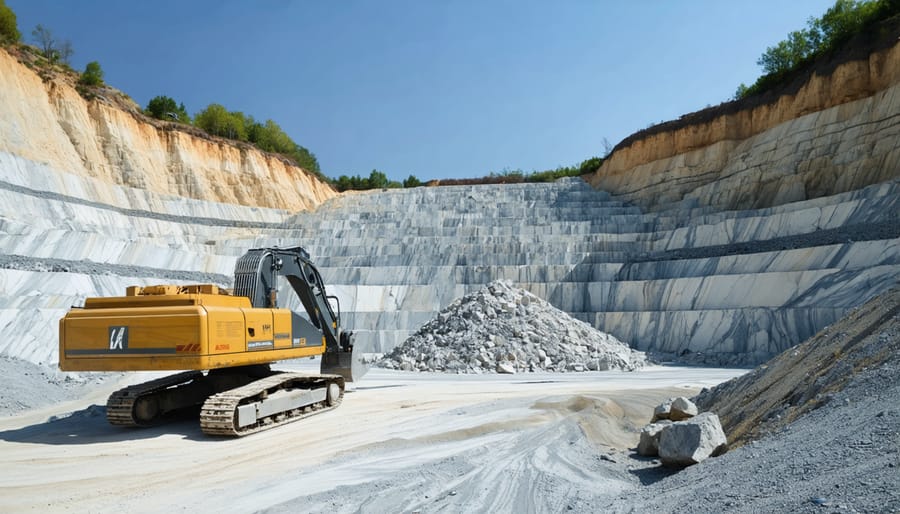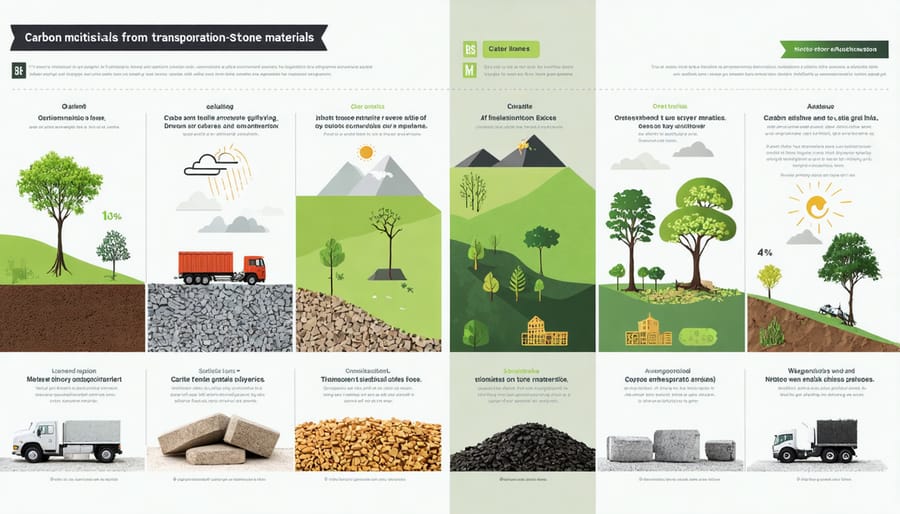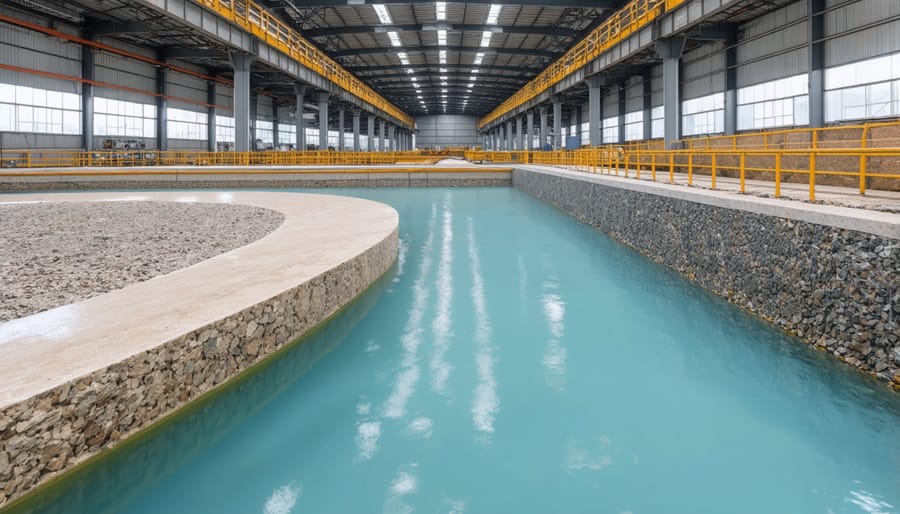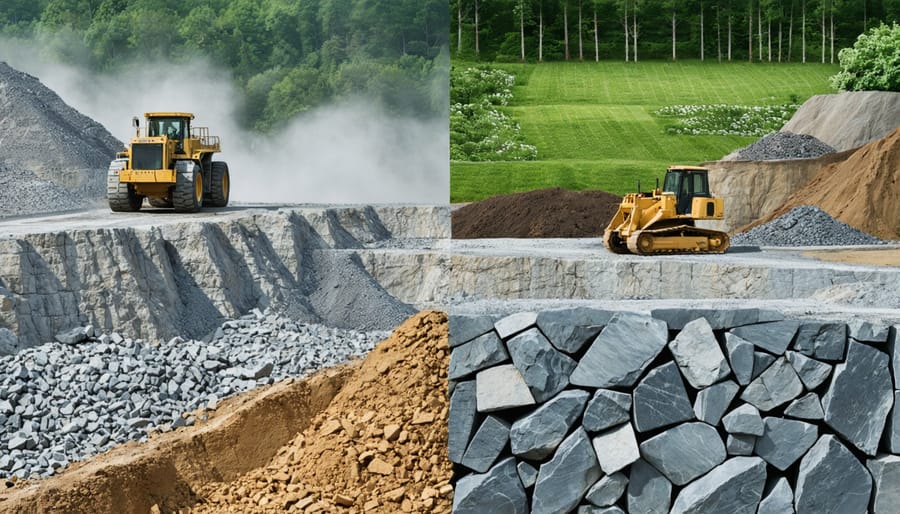The true environmental cost of human activity extends far beyond immediate financial calculations. As our planet grapples with climate change, resource depletion, and ecosystem disruption, understanding these hidden costs has become crucial for sustainable decision-making. Every product we consume, building we construct, and service we utilize leaves an environmental footprint – from carbon emissions and water pollution to habitat destruction and biodiversity loss.
Natural stone extraction, processing, and transportation represent a perfect case study of these complex environmental trade-offs. While stone is celebrated as a durable, natural building material, its journey from quarry to construction site involves significant energy consumption, landscape alteration, and potential ecosystem impacts. Yet when compared to manufactured alternatives, natural stone often demonstrates superior long-term sustainability through its longevity, minimal maintenance requirements, and potential for reuse.
Modern environmental cost analysis demands a holistic approach that considers the entire lifecycle of materials and processes. This means evaluating not just immediate environmental impacts, but also long-term effects on ecosystems, human health, and climate stability. For businesses and consumers alike, understanding these environmental costs has become essential for making responsible choices that balance immediate needs with long-term planetary health.
Extraction Impact: From Quarry to Construction Site

Energy Consumption in Quarrying
The extraction of natural stone requires significant energy input, primarily in the form of electricity and fossil fuels to power heavy machinery and cutting equipment. Modern quarrying operations typically consume between 100 and 150 kilowatt-hours (kWh) per cubic meter of stone extracted, though this can vary based on the hardness of the stone and extraction methods used. The implementation of stricter environmental regulations in quarrying has pushed the industry to adopt more energy-efficient technologies.
Diamond wire saws, which are commonly used in dimension stone quarrying, require substantial power but offer improved efficiency compared to older extraction methods. The carbon footprint of quarrying operations typically ranges from 170 to 250 kg CO2 equivalent per cubic meter of stone extracted. However, these figures can be significantly reduced through the adoption of renewable energy sources and optimization of cutting processes.
Many modern quarries are implementing energy management systems and investing in renewable energy installations, such as solar panels and wind turbines, to offset their power consumption. Some operations have reported energy savings of up to 30% through the implementation of variable speed drives on processing equipment and the use of energy-efficient lighting systems. These improvements not only reduce environmental impact but also help control operational costs in the face of rising energy prices.
Landscape and Ecosystem Effects
Quarrying operations significantly alter local landscapes and ecosystems, creating both immediate and long-term environmental impacts. The extraction process typically involves removing vegetation, topsoil, and rock layers, which can disrupt natural habitats and wildlife corridors. These changes often lead to the displacement of local flora and fauna, particularly affecting species that depend on specific geological formations or vegetation types.
The creation of quarry faces and excavation sites can alter natural drainage patterns and groundwater systems. This modification may affect local water tables and impact neighboring wetlands or water bodies, potentially disrupting aquatic ecosystems. Additionally, the removal of natural rock formations can eliminate unique microhabitats that support specialized plant and animal species.
However, many modern quarrying operations now implement progressive rehabilitation strategies. These include maintaining buffer zones around sensitive areas, creating artificial wetlands, and developing new habitats within inactive quarry sections. Some rehabilitated quarries have successfully transformed into nature reserves or recreational areas, supporting new ecosystems and biodiversity.
The dust generated during extraction can settle on surrounding vegetation, affecting plant growth and local air quality. To mitigate these effects, quarry operators employ dust suppression techniques and maintain vegetation barriers. Regular environmental monitoring helps assess and manage these impacts, ensuring compliance with ecological preservation standards and local environmental regulations.
Transportation and Processing Footprint
Carbon Emissions in Transport
Transportation represents a significant portion of natural stone’s environmental footprint, primarily through carbon emissions generated during shipping and delivery. The global transportation impacts of stone materials vary considerably depending on the distance between quarries and construction sites.
Heavy stone blocks and slabs require substantial fuel consumption for transportation, whether by sea freight, rail, or truck. For example, shipping a container of marble from Italy to North America can generate approximately 2-3 metric tons of CO2 emissions. Local sourcing can significantly reduce these emissions, with truck transportation typically producing 60-150g of CO2 per ton-mile, compared to international shipping’s higher carbon footprint.
To minimize transportation-related environmental impacts, many projects now prioritize regional stone sources when possible. This approach not only reduces carbon emissions but also supports local economies and maintains shorter supply chains. Industry innovations in logistics and route optimization have helped reduce unnecessary transportation distances, while the adoption of more fuel-efficient vehicles and alternative fuels continues to lower emissions per mile.
Some manufacturers are implementing carbon offset programs specifically targeting transportation emissions, while others invest in electric and hybrid delivery vehicles for local distribution. These initiatives, combined with careful planning and sourcing strategies, help mitigate the environmental costs of stone transportation.

Processing Energy Requirements
The processing of natural stone requires significant energy input, particularly during cutting, polishing, and finishing stages. Modern stone processing facilities utilize heavy-duty diamond wire saws, gang saws, and polishing machines that consume substantial electrical power. A typical stone processing plant may use between 30-50 kilowatt-hours (kWh) of electricity per ton of processed stone, depending on the material hardness and finished product specifications.
Water-jet cutting technology, while more precise, can consume up to 20% more energy than traditional methods. However, these systems often provide better material yield, potentially offsetting their higher energy demands through reduced waste. Polishing processes are particularly energy-intensive, requiring multiple stages of increasingly fine abrasives to achieve the desired finish.
Recent technological advances have introduced more energy-efficient equipment, including variable-speed motors and regenerative systems that can reduce power consumption by up to 25%. Some facilities have begun implementing solar panels and other renewable energy sources to offset their grid electricity usage. Energy recovery systems are also becoming more common, capturing and reusing heat generated during processing.
The industry continues to invest in research and development of more efficient processing methods. Manufacturers are increasingly adopting energy management systems and implementing regular maintenance schedules to ensure equipment operates at optimal efficiency levels, helping to reduce both environmental impact and operational costs.
Economic Benefits vs. Environmental Trade-offs
Long-term Durability Advantages
Natural stone stands out as one of the most durable building materials available, with a lifespan that can extend for centuries. This exceptional longevity directly contributes to the long-term value of natural stone while significantly reducing its environmental impact through decreased replacement needs.
Unlike manufactured materials that may require replacement every 10-20 years, properly maintained natural stone installations can last for generations. This durability translates into fewer resources consumed for replacements, reduced manufacturing emissions, and minimal waste entering landfills over time. Historic buildings throughout the world demonstrate stone’s remarkable staying power, with many structures remaining intact and functional after hundreds of years of use.
The environmental benefits of this longevity are substantial. When considering the total lifecycle impact of building materials, the reduced need for replacement and maintenance of natural stone results in lower cumulative energy consumption and carbon emissions. For example, a limestone facade that lasts 100 years eliminates the need for multiple replacements of alternative materials, each of which would require new resource extraction, processing, and transportation.
Additionally, natural stone’s durability maintains its aesthetic and functional properties without requiring chemical treatments or extensive refinishing, further reducing its environmental footprint through minimal maintenance requirements.
Recyclability and Reuse Potential
Natural stone stands out as one of the most recyclable building materials available, offering multiple opportunities for reuse throughout its lifecycle. Unlike many manufactured materials, stone can be repurposed almost indefinitely without losing its essential characteristics or structural integrity.
When buildings containing natural stone are demolished or renovated, the stone elements can be salvaged and reprocessed for various applications. Large stone pieces can be cut down for new construction projects, while smaller fragments find use in aggregate, road base materials, or landscape features. This versatility significantly reduces waste and the demand for new stone extraction.
The durability of natural stone also contributes to its excellent reuse potential. Historic buildings demonstrate how stone elements can remain structurally sound and aesthetically pleasing for centuries, often outlasting other building components. When such structures are renovated, the original stone can often be cleaned, refinished, and reintegrated into the new design.
Moreover, stone waste from quarrying and fabrication processes can be utilized in various applications. Stone dust and small particles serve as mineral fillers in concrete, while larger pieces become decorative elements in landscaping or architectural features. This comprehensive recyclability helps offset the environmental impact of initial extraction and processing, making stone a more sustainable choice when considered over its entire lifecycle.
Local Economic Impact
The natural stone industry creates significant economic opportunities in local communities, particularly in regions with abundant stone deposits. Quarrying operations typically employ dozens of workers directly, from skilled stonecutters to equipment operators and site managers. These jobs often provide above-average wages and long-term employment stability, contributing to the economic health of rural areas where quarries are commonly located.
Beyond direct employment, the industry supports numerous auxiliary businesses, including transportation companies, equipment suppliers, and maintenance services. Local contractors, architects, and construction firms benefit from having ready access to stone materials, often leading to reduced transportation costs and faster project completion times.
However, these economic benefits must be weighed against potential environmental costs. While quarries generate local tax revenue and stimulate business growth, they can also impact property values in surrounding areas due to noise, dust, and altered landscapes. Communities must carefully balance these factors through proper planning and regulation.
Many quarry operators now implement comprehensive site restoration plans, creating new opportunities for land use after extraction ends. Some restored quarries have been transformed into recreational areas, wildlife habitats, or water reservoirs, providing long-term community assets that partially offset the initial environmental impact.
The industry’s evolution toward more sustainable practices has also created new job opportunities in environmental management, restoration ecology, and green technology implementation, demonstrating how environmental responsibility and economic growth can coexist in the natural stone sector.

Sustainable Practices in Natural Stone Industry
The natural stone industry has made significant strides in implementing sustainable practices throughout its operations. Modern quarries now employ advanced extraction techniques that minimize waste and reduce environmental impact. These methods include precision cutting technologies, water recycling systems, and comprehensive site rehabilitation plans.
Leading stone producers have adopted closed-loop water systems that recycle up to 98% of water used in processing. This innovation dramatically reduces water consumption while preventing contamination of local water sources. Additionally, many quarries now utilize renewable energy sources, such as solar and wind power, to offset their carbon footprint.
Waste reduction initiatives have become increasingly sophisticated, with companies finding innovative ways to repurpose stone remnants. These byproducts are being transformed into aggregate for construction, soil amendments for agriculture, and even artistic installations. Such practices not only minimize environmental impact but also create additional revenue streams, contributing to sustainable investment benefits.
The industry has also embraced certification programs that verify environmentally responsible practices. These programs assess factors such as quarry management, processing efficiency, and transportation optimization. Many manufacturers now provide environmental product declarations (EPDs) that detail their products’ lifecycle impacts, enabling architects and designers to make informed decisions.
Looking ahead, emerging technologies such as electric quarry equipment and advanced recycling systems promise to further reduce the industry’s environmental footprint. These innovations, combined with stringent sustainability standards and transparent reporting, demonstrate the natural stone sector’s commitment to environmental stewardship while maintaining product quality and economic viability.
The environmental impact of natural stone is a complex equation that requires careful consideration of multiple factors. While quarrying and processing operations do have notable environmental costs, including energy consumption, water usage, and landscape modification, these impacts must be weighed against the material’s exceptional durability and longevity. Natural stone’s ability to last for centuries significantly reduces its lifetime environmental footprint compared to materials requiring frequent replacement.
Modern sustainable practices in the stone industry, such as water recycling systems, improved quarrying techniques, and waste material repurposing, are actively reducing the sector’s environmental impact. Additionally, stone’s natural thermal properties can contribute to building energy efficiency, while its local sourcing potential can reduce transportation-related emissions.
When making decisions about natural stone use, consider the complete lifecycle impact rather than just initial extraction costs. By choosing responsibly sourced stone, working with certified suppliers who implement sustainable practices, and planning for optimal material use, projects can effectively balance environmental concerns with the material’s inherent benefits. This approach ensures that natural stone remains a viable choice for sustainable construction while supporting continued industry improvements in environmental stewardship.










